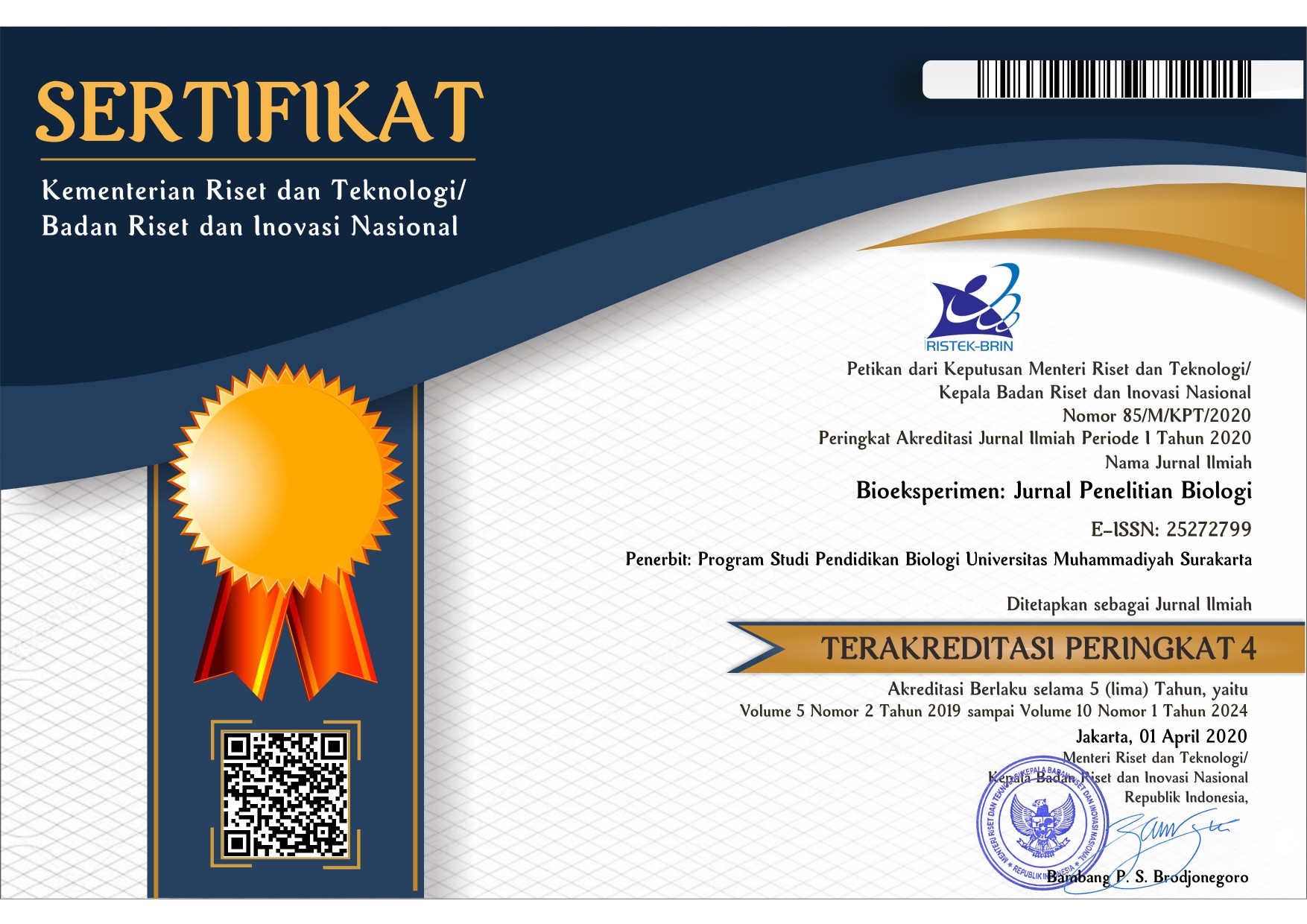UJI RESISTENSI ISOLAT KHAMIR YANG DIISOLASI DARI LIMBAH INDUSTRI DI RUNGKUT, SURABAYA, INDONESIA
Salomo Christian(1*), Wahyu Irawati(2)(1)
(2) Fakultas Sains dan Matematika, Program Studi Biologi Universitas Pelita Harapan
(*) Corresponding Author
Abstract
Sampel diambil dari lumpur aktif pusat pengolahan limbah PT. SIER Surabaya. Isolasi dilakukan dengan pengenceran sampel limbah kemudian diinokulasikan dengan metode sebar ke dalam medium Yeast Extract Peptone Dextrose Agar yang diperkaya dengan CuSO4. Uji resistensi dilakukan dengan menginokulasikan isolat murni dengan metode gores ke dalam medium Agar yang mengandung berbagai konsentrasi CuSO4 untuk menentukan nilai Minimum Inhibitory Concentration (MIC). Hasil isolasi diperoleh delapan isolat khamir dengan kode ES6.1, ES8.1, ES9.2, ES9.3, ES9.4, ES9.5, ES10.2, dan ES10.4. Nilai MIC isolat khamir tersebut berkisar antara 16-20 Mm CuSO4. Isolat yang paling resisten adalah isolat dengan kode ES9.3 dengan nilai MIC= 20 mM CuSO4 , sehingga isolate ini dipilih sebagai isolate yang paling resisten terhadap polutan di Wilayah Rungkut, Surabaya, Indonesia.
Keywords
Full Text:
PDF (Bahasa Indonesia)References
Ashish, B., Neeti, K., & Himanshu, K. (2013). Copper Toxicity: A Comprehensive Study-Review paper. Research Journal of Recent Sciences , Vol. 2 (ISC-2012), 58-67.
Batool, I., Andleeb, S., Ali, S., Akhtar, K., & Ali, N. M. (2017). Accumulation of Heavy Metals by Living and Dead Bacteria as Biosorbents: Isolated from Waste Soil. Pak. j. sci. ind. res. Ser.B: biol. sci., Vol 60(2) 106-115.
Davis, T., Volesky, B., & Vieira, R. (2000). Sargassum as Biosorbents For Haevy Metals . Wat. Res., Vol. 34, No. 17; 4270-4278.
Hocheng, H., Chakankar, M., & Jadhav, U. (2018). From Guinea Worm Scourge to Metal Toxicity in Ebonyi State, Chemistry in Nigeria as the New Millennium Unfolds. Florida, USA: CRC
Press Taylor & Francis Group.
Irawati, W., Parhusip, A. J., Christian, S., & Yuwono, T. (2017). The potential capability of bacteria and yeast strains isolated from Rungkut Industrial Sewage in Indonesia as a bioaccumulators and biosorbents of copper .Biodiversitas , Vol 18, No. 3 : 971-977 .
Irawati, W., Patricia, Soraya, Y., & Baskoro, A. H. (2012). A Study on Mercury-Resistant Bacteria Isolated from a Gold Mine in Pongkor Village, Bogor, Indonesia. HAYATI Journal of
Biosciences, Vol. 19 No. 4, p 197-200.
Irawati, W., Riak, S., Sopiah, N., & Sulistia, S. (2017). Heavy metal tolerance in indigenous bacteria isolated from the industrial sewage in Kemisan River, Tangerang, Banten, Indonesia . Biodiversitas , Vol 18, No. 4 : 1481-1486.
Jianlong, W. (2002). Process Biochemistry , Vol 37 : 847–850.Kobya, M., Demirbas, E., Senturk, E., & Ince, M. (2005). Adsorption of heavy metal ions fromaqueous solutions by activated carbon prepared from apricot stone-Short Communication.Bioresource Technology, 96 : 1518–1521.
Nies, D. H. (1999). Microbial heavy-metal resistance. Appl Microbiol Biotechnol (1999) 51:730±750 , Vol 51: 730±750 .
Qayyum, S., Khan, I., Maqbool, F., Zhao, Y., & Peng, C. (2016). Isolation and Characterization of Heavy Metal Resistant Fungal Isolates from Industrial Soil in China. Pakistan J. Zool , Vol.48(5), pp. 1241-1247.
Wan, J., Zhang, X.-C., Neece, D., Ramonell, K. M., Clough, S., Kim, S.-y., . . . Stacey, G. (2008).A LysM Receptor-Like Kinase Plays a Critical Role in Chitin Signaling and Fungal Resistancein Arabidopsis. The Plant Cell, Vol. 20: 471–481.
Article Metrics
Abstract view(s): 1698 time(s)PDF (Bahasa Indonesia): 4289 time(s)
Refbacks
- There are currently no refbacks.








